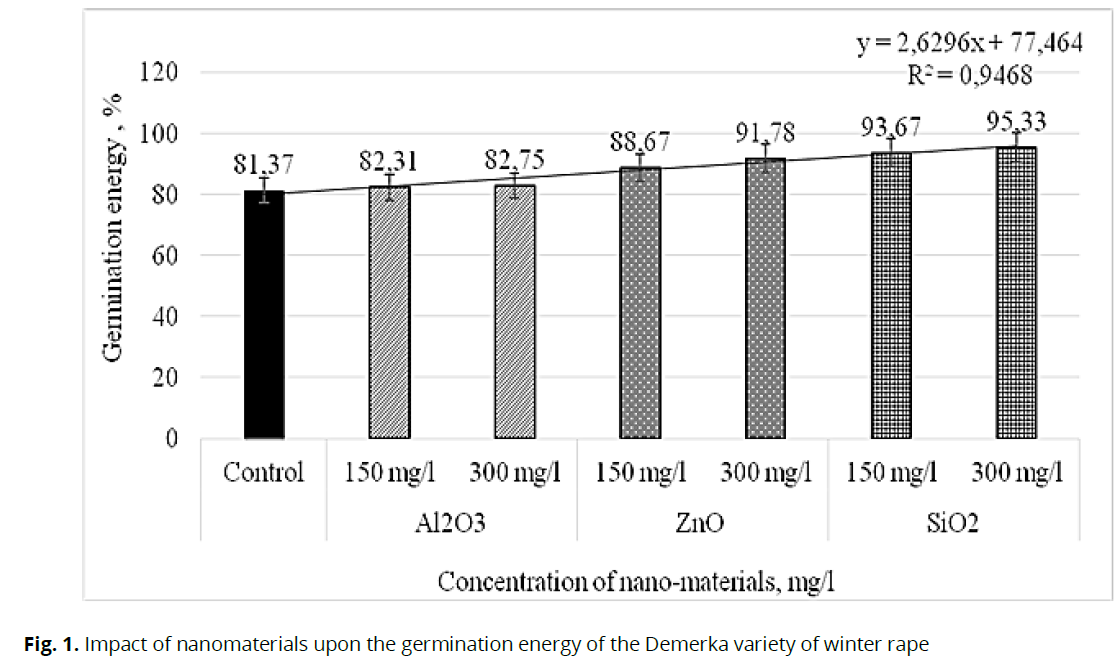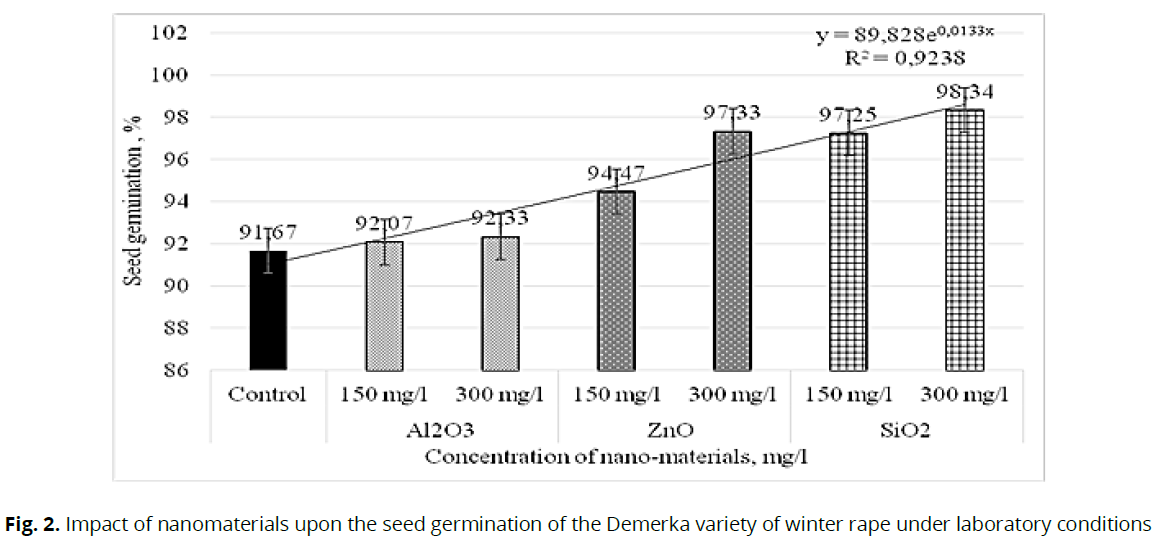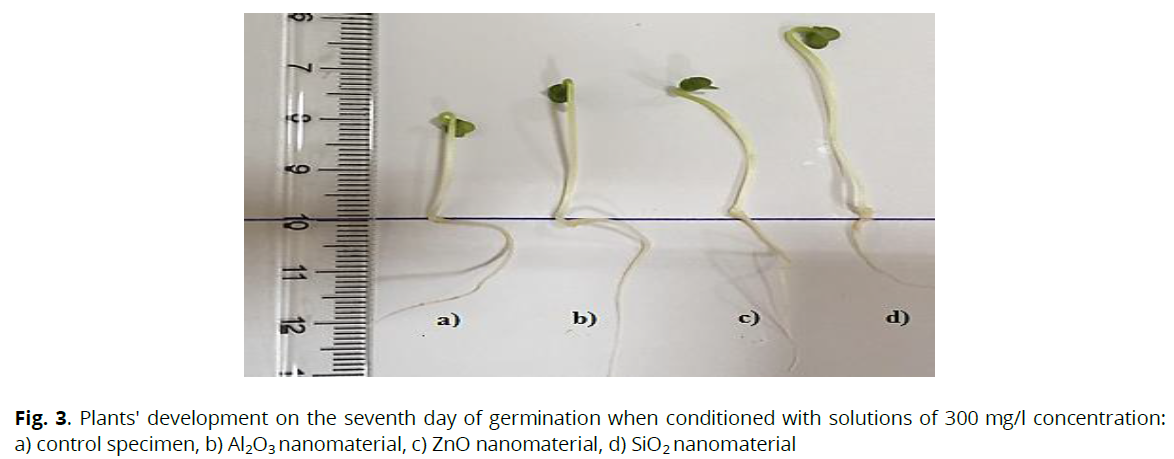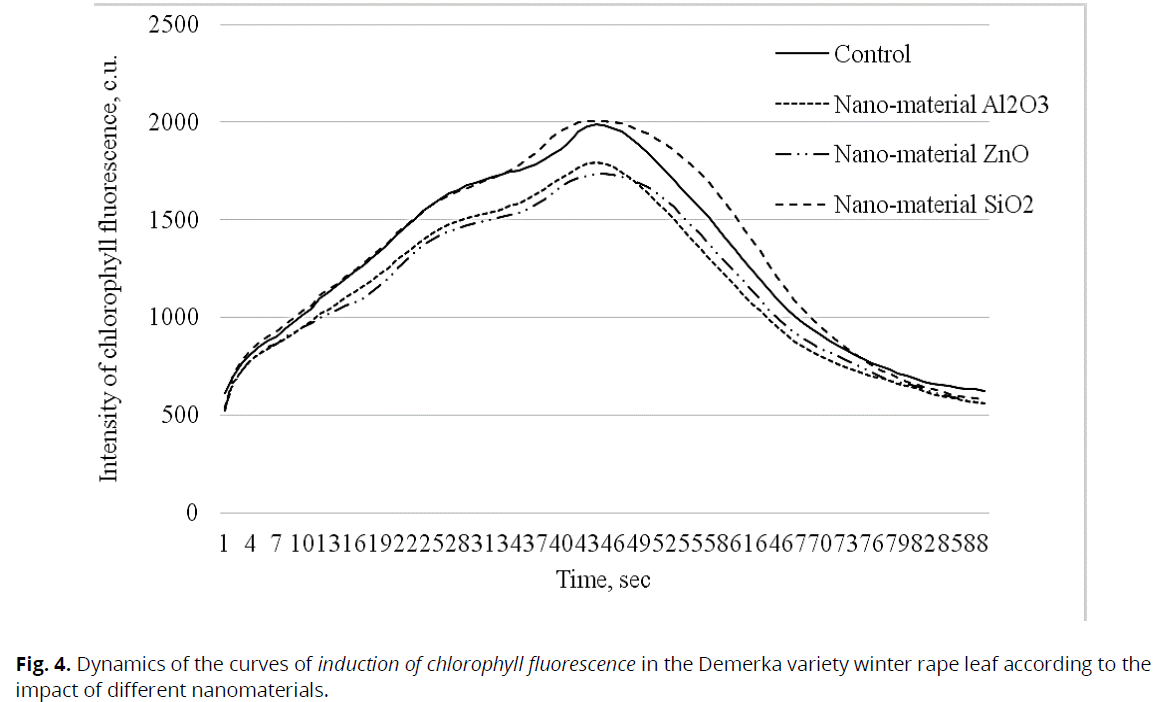Research - (2021) Volume 11, Issue 3
Abstract
Objectives. Assessing the impact of nanosize materials of diverse concentrations upon the physiological indices of winter rape's Demerka variety. Methods: laboratory (method of induction of chlorophyll fluorescence, methods of identifying the seeds' sowing properties, and biometric indices of winter rape's plants), statistics. Results. This article discusses the analysis results targeting the impact of nanosize materials upon the physiological indices of winter rape's Demerka variety. The research proves that preliminary soaking the seeds in nanomaterials' solutions increases the energy germination and seed germination of winter rape's Demerka variety. The highest indices of the said variety's energy of germination and seed germination were provided by the influence of the SiO2 (95,3 and 98,3%) and ZnO (91,8 and 97,3%) nano-materials 300 mg/l concentration. The length of the winter rape's seedlings increased due to the prior processing of the seeds with the SiO2 and ZnO nanomaterials. The highest indices of the seedlings' stem' growth were provided by using the SiO2 nanomaterial in 300 mg/l concentration, as the stem parts of the said seedlings appeared to be 81% longer than those in the control group. The highest index of the seedlings' root segment (30,5 % extra growth compared to the control group) was provided by the impact of the ZnO nanomaterial in 150 mg/l concentration. Sowing and biometric indices of winter rape plants were virtually unaffected by the Al2O3 nanomaterial. The nanomaterials under analysis do not impede chlorophyll fluorescence induction in the plants of winter rape of the Demerka variety. Conclusions. The use of the SiO2 and ZnO nanomaterials in 300 mg/l concentration for the pre-sowing processing of the seeds of winter rape's Demerka variety causes the activation of growth parameters and improves induction of chlorophyll fluorescence.
Keywords
nanomaterials, winter rape, seeds, growth processes, physiological parameters, germination energy, and seed germination.
Introduction
Recent years have been marked by rapeseed actively overtaking the oil market (Nizova, & Dubovskaya, 2006). This crop has resulted in the emergence of new trends in food and technical biotechnology. Unique biological and chemical properties of rape oil determine its use outside the food and technical industries, primarily in producing new ecologically friendly fuel known as biodiesel (Rudnyk-Ivashchenko et al., 2014). Obtaining substantial yields of winter rape requires the following optimal correlations of vital factors at all plant growth and development stages. A balanced fertilizing system is an essential means of increasing crop yield, winter rape in particular. Therefore, improving fertilizing systems via introducing new fertilizers that contain nanomaterials is recognized as of current importance. The use of nanomaterials in ultimately low concentrations is believed to be promising, as it allows producing eco-friendly crops (Taran, Batsmanova, Lopatko, & Kalenska, 2011). Due to their miniature size, nanoparticles can penetrate plants' tissues and impact the metabolism of whole organisms. In this regard, nanoparticles of metals appear to be of exceptional interest, for they demonstrate considerably lower toxicity than the particles of metals' salts. (Kalenska, Lopatko, & Novictska, 2011). The use of sets of nano-metals in plant growing is promising due to their low toxicity, affinity to living cells, and antioxidant properties (Taran, Batsmanova, Lopatko, & Kalenska, 2011; Kalenska, Lopatko, & Novictska, 2011; Gonchar, 2016; Klymenko et al., 2020). Pre-sowing processing of rape's seeds with nanopowder of iron facilitates the root system's growth. It increases leaves' photo-synthetic area and water-containing capacity, the plants' resistance to illnesses, and, eventually, provides a more significant yield of higher quality (Vinogradov, 2014).
This research targets the impact assessment of metal oxides' based nanomaterials upon the growth and development of plants (winter rape in particular) regarding their future use as nano-fertilizers.
Materials and Methods
The research was carried out at the laboratory of Biosensors (the National University of Life and Environmental Scienсes of Ukraine) in 2018-2020.
The research involved winter rape of the Demerka variety (distribution right holder: Prykarpatska state agricultural research facility of the National Academy of Agrarian Sciences of Ukraine) and nanoparticles of zinc oxide (<100 nm), aluminum (<50 nm), and silicon (10-20 nm), (Sigma Аldrich).
Winter rape of the Demerka variety was used to analyze nanomaterials' impact on plants' condition. Research protocols involved different variants of seeds' processing. The latter was implemented via 8-hours-long soaking the seeds of winter rape in nanomaterials' solutions, namely:
Control group - seeds soaked in water;
variant 1 – seeds soaked in ZnO nanomaterial in 150 mg/l concentration;
variant 2 – seeds soaked in ZnO nanomaterial in 300 mg/l concentration;
variant 3 – seeds soaked in Al2O3 nanomaterial in 150 mg/l concentration;
variant 4 – seeds soaked in Al2O3 nanomaterial in 300 mg/l concentration;
variant 5 – seeds soaked in SiO2 nanomaterial in 150 mg/l concentration;
variant 6 – seeds soaked in SiO2 nanomaterial in 300 mg/l concentration.
Germination of the rape's seeds was assessed via the standard procedure of DSTU 4138 – 2002. Parallel to the germination under laboratory conditions, the seeds' germination energy was identified, the latter being the ability for rapid and simultaneous sprouting (Kyrpa, Scota, Bazileva, & Lupitko, 2016; Kyrpa, & Paschenko, 2003). Vegetation analysis was carried out in the phytoclimatic cameras "Silver box evolution". Pre-processed seeds of Demerka variety winter rape were planted into a phytotron containing plastic vessels of 2-5l capacity, while expanded clay was used as filling substrate. Twenty plants were grown in each vessel; the procedure was repeated 3-4 times. Plants were grown under the temperature of 18-25 °C and illuminated with an SHP-TS Gro Lux lamp (dark period of 9 hours, light period of 15 hours). The temperature was sustained at 20-25/18-20 °C (day/night regimes).
Each plant that demonstrated a seedling and a root underwent the seedling's measuring with a ruler (Moiseychenko, Trifonova, Zaveryukha, & Eshchenko, 1996; Gritsaenko, & Karpenko, 2003).
The kinetics of changes in the induction of chlorophyll fluorescence (ICF) was measured with a portable chrono-fluorometer "Floratest" (Ukraine) at the laboratory of biosensory studies at the Chair of Molecular Biology, Microbiology and Biological Security of the National University of Life and Environmental Scienсes of Ukraine. Taking measures with the said device is not time-consuming and does not require damaging an object's native structure, thus contributing to the induction of the chlorophyll fluorescence method's extensive implementation in studies of plants' photosynthesis apparatuses (Brayon, Korneev, Snegur, & Kitaev, 2000; Korneev, & Kochubei, 2000) .
Adaptation of rape leaves to darkness was assessed within 5 min periods. The ICF parameters were measured at the 3-leaves' phase in the central segment of the formed leaf blade at identical tiers; plants that grew from the previously water-processed seeds were used as the control group; plants that grew from the seeds previously conditioned with solutions of nanomaterials in 300 mg/l concentration became samples for analysis. The concentration mentioned above of nanomaterials in solutions had proved to increase seeds' sowing quality and plants' growing index.
The intensity of chlorophyll fluorescence was measured in a triple iteration in 90 locations for each variant at intervals ranging from 3 msec up to 300 sec (Brayon, Korneev, Snegur, & Kitaev, 2000; Korsunsky, & Snegur, 1997; Kovalyshyn, Pinchuk, Taran, & Shvets, 2016); the obtained readings were transposed into "conventional units" (c.u.). Induction curves modeled in Microsoft Excel were employed in the analysis of the amplitude and temporal parameters of its discrete phase (Brayon, Korneev, Snegur, & Kitaev, 2000).
Results
We assessed the impact of nanomaterials upon the sowing qualities of winter rape. Seeds' pre-sowing conditioning is a prerequisite stage of the highly effective technology of winter rape's growing. This process allows employing protectors, micro-fertilizers, growth stimulators, and other adaptogens that facilitate the plants' growth and development (Savchuk, Starodub, Bisio, Guidotti, & Lisovyy, 2018). Seeds' germination and their energy and crop capacity are directly dependant as the former determines the plants' standing density and productivity, integrally manifesting several genetic, soil, hydro-thermal, biotic, and anthropogenic factors (Das, Mukherjee, Sengupta, & Singh, 2020; Makrushin, 2011; Patel, Kim, Dutta, Ganguly, Lim, 2020; DSTU 2240-93, 1994).
Pre-sowing soaking of winter rape's seeds with hydro solutions of nanomaterials under laboratory conditions resulted in the rise in germination energy (Fig. 1).

Fig 1: Impact of nanomaterials upon the germination energy of the Demerka variety of winter rape
The seeds of the Demerka variety of winter rape previously soaked in nanomaterials demonstrated average germination energy, which exceeded the control value by 9,5%.
The highest indices were registered using the SiO2 and ZnO nanomaterials in the concentration of 300 mg/l, being 95,3% and 91,8%, respectively. The use of the Al2O3 nanomaterial in the concentration of 300 mg/l germination energy appeared to be 82,8%.
The use of nanomaterials also stimulated the germination of winter rape (Fig. 2). The highest indices were registered using the SiO2 and ZnO nanomaterials in the concentration of 300 mg/L, which exceeded the control value by 7,3 % and 6,2%, respectively. The index of germination rate under the impact of the Al2O3 nanomaterial was 92,2%. Thus, zinc and silicon are identified as essential for winter rape. Nanoparticles of aluminum did not result in any significant changes in the indices mentioned above.

Fig 2: Impact of nanomaterials upon the seed germination of the Demerka variety of winter rape under laboratory conditions
Analysis of the impact of nanomaterials upon winter rape's morphological features. The results of the analysis of nanomaterials' influence upon the winter rape's seeds' morpho-physiological features testify that the said nanomaterials used in the 300 mg/l concentration improved the seedlings' growth indices (Fig. 3).

Fig 3: Plants' development on the seventh day of germination when conditioned with solutions of 300 mg/l concentration: а) control specimen, b) Al2O3 nanomaterial, c) ZnO nanomaterial, d) SiO2 nanomaterial
Compared to other nanomaterials, the SiO2 nanomaterial proved to provide more potent stimuli to the growth of the surface parts of winter rape's seedlings (Fig. 3). The plants conditioned with the ZnO nanomaterial demonstrated longer roots than those treated with SiO2.
When soaking the seeds with the Al2O3 nanomaterial, the indices of the surface and root parts of winter rape exceeded the control values by an average of 38% and 3%, respectively (Table 1).
| Variants | Concentration in hydro solution, mg/l | Height of the surface segment, sm | Length of the root system, sm |
|---|---|---|---|
| Control | - | 2,1±0,09 | 3,6±0,12 |
| 150 | 2,7±0,11 | 3,4±0,11 | |
| Nano-material Al2O3 | 300 | 3,1±1,07 | 3,9±0,14 |
| Nano-material ZnO | 150 | 2,6±0,03 | 4,7±0,21 |
| 300 | 2,8±0,15 | 4,6±0,18 | |
| Nano-material SiO2 | 150 | 3,5±0,13 | 2,6±0,07 |
| 300 | 3,8±0,16 | 2,7±0,03 |
Table 1. Morphophysiological indices of winter rape's seeds of Demerka variety conditioned with nanomaterials
Under the influence of the ZnO nanomaterial, the indices of the surface and root parts of winter rape's seedlings exceeded the control values by an average of 28,3% and 29,2%, respectively.
Pre-processing winter rape's seeds with the SiO2 nanomaterial stimulated the surface part of seedlings by an average of 73,8% compared to the control values, while the length of the root part decreased by 26,4%.
The best index stems of the winter rape's seedings' growth were provided by using the SiO2 nanomaterial in the concentration of 300 mg/L as the length of the stems exceeded the control value by 81 %. The highest indices of the roots' length were registered when the ZnO nanomaterial was used in the concentration of 150 mg/L, as the respective value exceeded the control one by 30,5 % (Table 1).
Analysis of the impact of nanomaterials upon the process of induction of chlorophyll fluorescence in winter rape's leaves.
Functions of the photosynthesis apparatus are susceptible to stress factors of biotic or abiotic etiology. Therefore, identifying the impact of diverse factors upon the plants' state requires express and informative methods of analysis that could be used both under laboratory and field conditions and result in minimal structural damage of the objects under analysis. The induction method of chlorophyll fluorescence meets these requirements and is widely used in modern research of photosynthetic processes (Brayon, Korneev, Snegur, & Kitaev, 2000; Doğru, & Çakirlar, 2020; Narimani, & Sharifi, 2020; Costenaro et al., 2017; Korneev, & Kochubei, 2000) .
The analysis of the Kautsky curves about the impact of the said metals' oxides provided several ICF indices (Fig. 4) and factors that allow assessing the impact of nanoparticles upon the state of plants and extend the analysis of the indices that characterize the light phase of photosynthesis and the effectiveness of photochemical reactions occurring at the dark phase of the absorbing the light energy (Narimani, & Sharifi, 2020).

Fig 4: Dynamics of the curves of induction of chlorophyll fluorescence in the Demerka variety winter rape leaf according to the impact of different nanomaterials.
The index of background fluorescence (F0) indicates the amount of inactive chlorophyll that demonstrates no functional connection with reaction centers ranged from 521 c.u. to 543 c.u. in the winter rape plants pre-conditioned with the nanomaterials. It was lower than that of the plants from the control group (611 c.u., see Table 2). Thus, we register the decrease in inactive chlorophyll in the experimental plants compared to the control ones and connect it to the structural transformation of winter rape's pigment complex triggered by the impact of nanomaterials.
| Variants | ICF parameters | ||||||||
|---|---|---|---|---|---|---|---|---|---|
| F0 | Fpl | Fmax | Fst | Fv | dFpl | dFpl/Fv | Fv/Fmax | (Fmax-Fst)/Fst | |
| Control | 611 | 1083 | 1983 | 624 | 1372 | 472 | 0,34 | 0,69 | 2,18 |
| Nano-material Al2O3 | 543 | 1031 | 1791 | 562 | 1248 | 488 | 0,39 | 0,70 | 2,19 |
| Nano-material ZnO | 536 | 1015 | 1730 | 562 | 1194 | 479 | 0,40 | 0,69 | 2,08 |
| Nano-material SiO2 | 521 | 1021 | 2001 | 581 | 1480 | 500 | 0,34 | 0,74 | 2,44 |
Table 2. Parameters of the induction of chlorophyll fluorescence in the Demerka variety conditioned with nanomaterials
The impact of the Al2O3, ZnO та SiO2 nanomaterials upon the plants resulted in the increase of the d Fpl index by 16.7, and 28 c.u. They are, respectively, compared to the control values (Table 2). These data testify to the rise in the ratio of fluorescence increasing from F0 to Fpl.
The stationary level of fluorescence is marked by the dynamic balance between the processes that determine the increase or decrease in fluorescence (Korneev, & Kochubei, 2000).
The plants conditioned with the nanomaterials demonstrated the Fst index lower by average 9% than that in the control group (Table 2).
The Fmax index indicates the highest level of fluorescence registered as a maximum on the induction curve. The plants conditioned with the SiO2 nanomaterial demonstrated the highest Fmax value of 2001 c.u. (Table 2).
Variability of fluorescence (Fv) is calculated as the difference between the Fmax and Fo. As a physiological index, Fv reflects the impact of environmental and experimental factors upon a plant.
The impact of the Al2O3, ZnO, and SiO2 nanomaterials on the plants provided the Fv of 1248, 1194, and 1480, respectively, while the Fv of 1372 c.u marked the control group (Table 2). These data provide yet another proof of the nanomaterials' influence upon the plants' physiological processes.
The Fv/Fmax indices depend on the efficiency of photochemical reactions of the Photo System2 (PhS2). Regarding dark-adapted plants, this ratio reflects the potential quantum efficiency of PhS2. It is used as an indicator of photosynthesis productivity while its optimal value does not exceed 0,83 for most plants' varieties, provided the exciting light's intensity is saturation (Shavanova, Taran, Marchenko, & Starodub, 2013). According to the analysis data, the Fv/Fmax ratio remained within 0,69-0,74 c.u., i.e., photosynthesis occurred at a standard rate in both experimental and control plants (Savchuk, & Starodub, 2017).
The efficiency of photochemical energy transformation in PhS2 was calculated as (Fmax – Fst)/Fst, which is an integrated index of photosynthesis characterizing the speed of electrons' linear transportation (Leshchenko, Kolesnichenko, Kytayev, Leshchenko, & Dradrach, 2015). This index varied within 2,08 – 2,44 c.u. for the plants under analysis.
Conclusion
The experiment results prove that soaking the seeds of winter rape's Demerka variety in solutions of nanomaterials before sowing increases their germination energy and germination seed. The highest indices of the said variety's energy of germination and seed germination were provided by the influence of the SiO2 (95,3 and 98,3%) and ZnO (91,8 and 97,3%) nanomaterials 300 mg/l concentration. The length of the winter rape's seedlings increased due to the prior processing of the seeds with the SiO2 and ZnO nanomaterials. The highest indices of the seedlings' stems' growth were provided by using the SiO2 nanomaterial in 300 mg/l concentration, as the stems' length exceeded the control value by 81%. The highest index of the seedlings' root segment was provided by the impact of the ZnO nanomaterial in 150 mg/l concentration exceeding the control value by 30,5 %. The experiment has proved that the nanomaterials under analysis do not impede the induction of chlorophyll fluorescence in the plants of winter rape of the Demerka variety.
References
Brayon, A., Korneev, D., Snegur, A., & Kitaev, O. (2000). Instrumental study photosynthetic apparatus usingfor chlorophyll fluorescence induction [method. Instructions for students. Biol. Ft.]. Kyiv. Kyivskyi universytet.
Costenaro, D., Bisio, C., Carniato, F., Taran, M.,â?¦ & Guidotti, M. (2017). Physicoâ??chemical properties, biological and environmental  impact  of  Nbâ??saponites  catalysts  for  the  oxidative  degradation  of  chemical  warfare agents. ChemistrySelect, 2(5),1812-1819. Doi: https://doi.org/10.1002/slct.201700042
Das, S., Mukherjee, A., Sengupta, G., & Singh, V. K. (2020). Overview of nanomaterials synthesis methods, characterization techniques and effect on seed germination. In Nano-Materials as Photocatalysts for Degradation of Environmental Pollutants (pp.371-401). Elsevier. Doi: https://doi.org/10.1016/B978-0-12-818598-8.00018-3
DoÄ?ru, A., & Ã?akirlar, H. (2020). Effects of leaf age on chlorophyll fluorescence and antioxidant enzymes activity in winter rapeseed     leaves     under     cold     acclimation     conditions. Brazilian     Journal     of    Botany,    43(1),     11-20. Doi: https://doi.org/10.1007/s40415-020-00577-9
DSTU 2240-93. (1994). Seeds of agricultural cultures. Varietal and sowing qualities. Specifications. Kyiv: State Standard of Ukraine.
Gonchar, L. M. (2016). Action of colloidal solution of copper and zinc on seed germination of oats. Visnyk Poltavskoyi Derzhavnoyi agrarnoyi akademiyi, 4, 45â??48. Doi: https://doi.org/10.31210/visnyk2016.04.08 (in Ukrainian)
Gritsaenko, Z., Grytsaenko, A., & Karpenko, V. (2003). Methods of biological and agrochemical researches of plants and soils. K.: JSC "Nichlava".
Kalenska, S, Lopatko, K, & Novictska, N. (2011). Efficiency of biogenic metals and bio-activebioactive drugs in soybean. Naukovi dopovidi NUBiP, 5(27). http://nd.nubip.edu.ua/2011_5/11ksm.pdf (in Ukrainian)
Klymenko, Т., Fedorchuk, S., Trembitska, O., Lisovyy, M., Didur, O., & Lykholat, Yu. (2020). Effect of fertilization on Solanum tuberosum   L.    Productivity   in   Ukrainian   polissya.   Ukrainian   Journal   of   Ecology,   10(3), 124â??130.   DOI: https://doi.org/10.15421/2020_145
Korneev, D. Yu., & Kochubei, S. M. (2000). Investigation of QV - reducing complexes of photosystem 2 by induction of fluorescence of chlorophyll. Physiology and biochemistry of cultivated plants, 32(1). 20â??24.
Korsunsky, V., & Snegur, A. (1997). Instruction toon the device "Floratete FT-1". Rost.
Kovalyshyn, I., Pinchuk, A., Taran, M., & Shvets, R. (2016). Chlorophyll fluorescence induction of the genus Clematis L. representatives leaves in kiev conditions. Naukovyi visnyk NUBiP Ukrainy. Seriia: Lisivnytstvo ta dekoratyvne sadivnytstvo, 238, 176â??84.
Kyrpa, M. Ya., & Paschenko, N. O. (2003). Methods of determining the similarity of high qualityhigh-quality corn seeds. Biuleten Instytutu zernovoho hospodarstva UAAN, 20, 60â??62.
Kyrpa, M.Ya., Scotar, S.O., Bazileva, Yu.S., & Lupitko O.I. (2016). Sowing characteristics of cereal seeds and methodology of their determination. Plant breeding and seed production, (110):171-79. Doi: https://doi.org/10.30835/2413-7510.2016.87625 (in Ukrainian)
Leshchenko, O., Kolesnichenko, O., Kytayev, O., Leshchenko, Yu., & Dradrach, A. (2015). Induction of chlorophyll fluorescence in plants leaf Lolium perenne. Biological Resources and Nature management, 7, 3/4. 11â??15.
Makrushin M.M. (2011). Seed production: textbook. Simferopol. Arial. P.440â??443.
Moiseychenko, F., Trifonova, M., Zaveryukha, A., & Eshchenko, V. (1996). Fundamentals of scientific research in agronomy. Moscow. Kolos.
Narimani, H., & Sharifi, R. (2020). Effect of foliar and soil application of zinc on photosynthetic pigments, chlorophyll fluorescence and grain yield of wheat under soil salinity. Journal of Soil Management and Sustainable Production,10(2), 89-105. Doi: https://doi.org/10.22069/EJSMS.2020.16140.1861
Nizova, G.K., & Dubovskaya, A.G. (2006). Biochemical study of spring and winter oilseed rape from the collection of VIR. N.I. Vavilova. Agrarian Russia, 6, 37-40. (in Russian)
Patel, D. K., Kim, H. B., Dutta, S. D., Ganguly, K., & Lim, K. T. (2020). Carbon nanotubes-based nanomaterials and their agricultural and biotechnological applications. Materials, 13(7), 1679.Doi: https://doi.org/10.3390/ma13071679
Rudnyk-Ivashchenko, O.I., Shovgun, Ð?.O., Ivanytska, A.P., Shcherbynina, N.P., Lyashenko, S.O., Chukhleb, S.L., & Badyaka, O.O. (2014). Biochemical properties of new varieties of rape. Variety research and protection of plant variety rights, 4, 29-33. Doi:10.21498/2518-1017.4(25).2014.55605 (in Ukrainian)
Savchuk, M., Starodub, M., Bisio C., Guidotti M., & Lisovyy M. (2018). Estimation of the efficiency of applying nanocomposites as environmentally safe nanofertilizers to stimulate biometric indices of agricultural crops. Agric. sci. pract, 5 (2), 64â??76. Doi: https://doi.org/10.15407/agrisp5.02.064
Savchuk, M.V., & Starodub, M.F. (2017). Influence of Nb-containing nanocomposites based on saponite on the induction of chlorophyll fluorescence in corn leaves. Scientific reports of the National University of Life and Environmental Sciences of Ukraine, 3 (67). Doi: http://journals.nubip.edu.ua/index.php/Dopovidi/article/viewFile/ 8724/8062
Shavanova, K. E., Taran, M. V., Marchenko, O. A., & Starodub, N. F. (2013). Express control of plants general state by using the new generation of the instrumental tools. In Biophotonics-Riga, 9032. 90320. Doi:10.1117/12.2044686
Taran, N.Yu., Batsmanova, L.M., Lopatko, K.G., & Kalenska, S.Ð?. (2011). The technology of environmentally safe use of nanoparticles in adaptive crop production. Fizyka zhyvoho, 19(2), 54â??58.
Vinogradov, D. (2014). Herbicides and their mixtures on crops of spring rape. Chief agronomist, 10, 21â??23.
Author Info
M.V. Savchuk1, M.M. Lisovyy2*, O.P. Taran2*, O.V. Voitsekhivska3, V.N. Belava3, O.O. Panyuta3, S.O. Tkachyk4, O.S. Demyanyuk5 and I.M. Klymchuk62National University of Life and Environmental Scienсes of Ukraine, Heroev Oborony Street, 13, Kyiv, 03041, Ukraine
3Taras Shevchenko National University of Kyiv, Volodymyrska Street, 64/13, Kyiv, 01601, Ukraine
4Ukrainian Institute for Plant Variety Examination, Henerala Rodymtseva Street, 15, Kyiv, 03041, Ukraine
5Institute of Agroecology and Environmental Management of NAAN, 12, Metrologichna Street, 12, Kyiv, 03143, Ukraine
6National Pirogov Memorial Medical University, Street Pirogova, 56, Vinnytsia, 21018, Ukraine
Citation: Savchuk, M.V., Lisovyy, M.M., Taran, O.P., Voitsekhivska, O.V., Belava, V.N., Panyuta, O.O., Tkachyk, S.O., Demyanyuk, O.S., Klymchuk, I.M. (2021). Impact of SiO2, Al2O3, and ZnO nanomaterials on the physiological parameters of winter rape. Ukrainian Journal of Ecology, 11 (3), 305-311.
Received: 02-May-2021 Accepted: 08-Jun-2021 Published: 31-May-2021, DOI: 10.15421/2021_176
Copyright: This is an open access article distributed under the terms of the Creative Commons Attribution License, which permits unrestricted use, distribution, and reproduction in any medium, provided the original work is properly cited.
